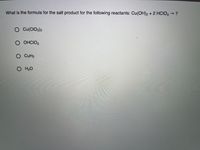
Chemistry & Chemical Reactivity
10th Edition
ISBN: 9781337399074
Author: John C. Kotz, Paul M. Treichel, John Townsend, David Treichel
Publisher: Cengage Learning
expand_more
expand_more
format_list_bulleted
Concept explainers
Question

Transcribed Image Text:What is the formula for the salt product for the following reactants: Cu(OH)2 + 2 HCIO3 → ?
Cu(CIO3)2
OHCIO3
O CuH2
O H2O
Expert Solution
This question has been solved!
Explore an expertly crafted, step-by-step solution for a thorough understanding of key concepts.
Step by stepSolved in 2 steps

Knowledge Booster
Learn more about
Need a deep-dive on the concept behind this application? Look no further. Learn more about this topic, chemistry and related others by exploring similar questions and additional content below.Similar questions
- You are given four different aqueous solutions and told that they each contain NaOH, Na2CO3, NaHCO3, or a mixture of these solutes. You do some experiments and gather these data about the samples. Sample A: Phenolphthalein is colorless in the solution. Sample B: The sample was titrated with HCl until the pink color of phenolphthalein disappeared, then methyl orange was added. The solution became pink. Methyl orange changes color from pH 3.01 (red) to pH 4.4 (orange). Sample C: Equal volumes of the sample were titrated with standardized acid. Using phenolphthalein as an indicator required 15.26 mL of standardized acid to change the phenolphthalein color. The other sample required 17.90 mL for a color change using methyl orange as the indicator. Sample D: Two equal volumes of the sample were titrated with standardized HCl. Using phenolphthalein as the indicator, it took 15.00 mL of acid to reach the equivalence point; using methyl orange as the indicator required 30.00 mL HCl to achieve neutralization. Identify the solute in each of the solutions.arrow_forwardPhosphate buffers are important in regulating the pH of intracellular fluids. If the concentration ratio of H2PO4/HPO42 in a sample of intracellular fluid is 1.1: 1, what is the pH of this sample of intracellular fluid? H2PO4(aq)HPO42(aq)+H+(aq)Ka=6.2108arrow_forwardHNO3(aq) + Fe(OH)3(s) →arrow_forward
- Complete the following chemical equations and identify if a precipitate is formed: Cr2(SO4)3(aq) + (NH4)2CO3(aq) → Ba(NO3)2(aq) + K2SO4(aq) →arrow_forwardThe following chemical reaction takes place in aqueous solution: MnCl₂(aq) + 2 KOH(aq) →Mn(OH)₂(s)+2 KCl(aq) Write the net ionic equation for this reaction. ៣ 7 0-0 Xx Śarrow_forwardThe following chemical reaction takes place in aqueous solution: 2FeCl3 (aq) + 3K2S (aq) → Fe2S3 (s) + 6KCl (aq)Write the net ionic equation for this reaction.arrow_forward
- The following chemical reaction takes place in aqueous solution: FeSO4(aq) + (NH4) S(aq) → FeS(s)+(NH4)₂SO4(aq) 2 Write the net ionic equation for this reaction.arrow_forwardThe following chemical reaction takes place in aqueous solution: Fe(NO3)₂(aq) + (NH4) S(aq) → FeS (s) + 2NH4NO3(aq) 2 Write the net ionic equation for this reaction. 0 ロ→ロ X ? 000 18 Ararrow_forwardWhich substance is the oxidizing agent in the reaction below?Fe(CO)5 (l) + 2HI (g) →→ Fe(CO)4I2 (s) + CO (g) + H2(g) HI Fe(CO)4I2 Fe(CO)5 H2 COarrow_forward
- The following chemical reaction takes place in aqueous solution: 2 FeCl3(aq) +3 K₂S(aq) →Fe₂S3(s)+6 KCl(aq) Write the net ionic equation for this reaction. 0 0-0 X Sarrow_forwardWrite a balanced chemical equation for the following reaction in a basic solution.ClO–(aq) + Cr(OH)3(s) → Cl–(aq) + CrO42–(aq)arrow_forwardPredict the products of the following reaction. If no reaction will occur, use the NO REACTION butto³ Be sure your chemical equation is balanced! Rb(s) + H₂O(1) → [] X NO ロ→ロ REACTION aarrow_forward
arrow_back_ios
SEE MORE QUESTIONS
arrow_forward_ios
Recommended textbooks for you
 Chemistry & Chemical ReactivityChemistryISBN:9781337399074Author:John C. Kotz, Paul M. Treichel, John Townsend, David TreichelPublisher:Cengage Learning
Chemistry & Chemical ReactivityChemistryISBN:9781337399074Author:John C. Kotz, Paul M. Treichel, John Townsend, David TreichelPublisher:Cengage Learning Chemistry & Chemical ReactivityChemistryISBN:9781133949640Author:John C. Kotz, Paul M. Treichel, John Townsend, David TreichelPublisher:Cengage Learning
Chemistry & Chemical ReactivityChemistryISBN:9781133949640Author:John C. Kotz, Paul M. Treichel, John Townsend, David TreichelPublisher:Cengage Learning Chemistry: The Molecular ScienceChemistryISBN:9781285199047Author:John W. Moore, Conrad L. StanitskiPublisher:Cengage Learning
Chemistry: The Molecular ScienceChemistryISBN:9781285199047Author:John W. Moore, Conrad L. StanitskiPublisher:Cengage Learning ChemistryChemistryISBN:9781305957404Author:Steven S. Zumdahl, Susan A. Zumdahl, Donald J. DeCostePublisher:Cengage Learning
ChemistryChemistryISBN:9781305957404Author:Steven S. Zumdahl, Susan A. Zumdahl, Donald J. DeCostePublisher:Cengage Learning Chemistry: An Atoms First ApproachChemistryISBN:9781305079243Author:Steven S. Zumdahl, Susan A. ZumdahlPublisher:Cengage Learning
Chemistry: An Atoms First ApproachChemistryISBN:9781305079243Author:Steven S. Zumdahl, Susan A. ZumdahlPublisher:Cengage Learning Chemistry: Principles and ReactionsChemistryISBN:9781305079373Author:William L. Masterton, Cecile N. HurleyPublisher:Cengage Learning
Chemistry: Principles and ReactionsChemistryISBN:9781305079373Author:William L. Masterton, Cecile N. HurleyPublisher:Cengage Learning

Chemistry & Chemical Reactivity
Chemistry
ISBN:9781337399074
Author:John C. Kotz, Paul M. Treichel, John Townsend, David Treichel
Publisher:Cengage Learning

Chemistry & Chemical Reactivity
Chemistry
ISBN:9781133949640
Author:John C. Kotz, Paul M. Treichel, John Townsend, David Treichel
Publisher:Cengage Learning

Chemistry: The Molecular Science
Chemistry
ISBN:9781285199047
Author:John W. Moore, Conrad L. Stanitski
Publisher:Cengage Learning

Chemistry
Chemistry
ISBN:9781305957404
Author:Steven S. Zumdahl, Susan A. Zumdahl, Donald J. DeCoste
Publisher:Cengage Learning

Chemistry: An Atoms First Approach
Chemistry
ISBN:9781305079243
Author:Steven S. Zumdahl, Susan A. Zumdahl
Publisher:Cengage Learning

Chemistry: Principles and Reactions
Chemistry
ISBN:9781305079373
Author:William L. Masterton, Cecile N. Hurley
Publisher:Cengage Learning